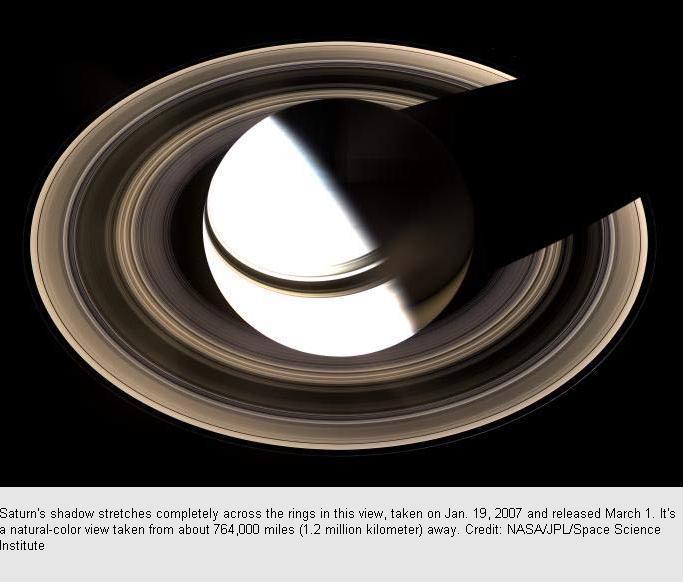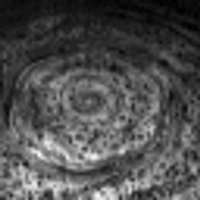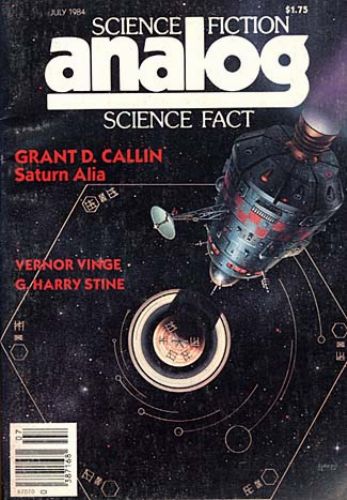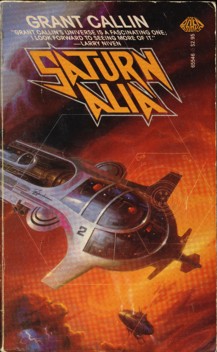« A Beer Before it Starts | Main | Sunset on Tims Ford »
March 30, 2007
Saturn Alia

On March 1, 2007, NASA released a stunning photograph of Saturn taken by the Cassini space probe.
The Cassini spacecraft has captured a fresh view of Saturn from high above the planet's gorgeous rings and also provided a stunning video of its travels through the ring plane.
The robotic probe has climbed to higher and higher inclinations over the past several months, providing looks at the planet and rings that scientists have eagerly awaited.
"Finally, here are the views that we've waited years for," said Carolyn Porco, Cassini imaging team leader at the Space Science Institute in Boulder, Colo. "Sailing high above Saturn and seeing the rings spread out beneath us like a giant, copper medallion is like exploring an alien world we've never seen before. It just doesn't look like the same place. It's so utterly breath-taking, it almost gives you vertigo."
The new photograph shows the rings from a 40-degree angle on high.
The video shows the rings as they appeared to Cassini while it sped from south to north, rapidly crossing the ring plane. When the rings are seen edge-on in the video, they disappear.
Now, things have gotten more interesting.

taken by the visual infrared mapping spectrometer onboard NASA's Cassini Orbiter
reveals a dynamic, active planet lurking underneath the ubiquitous cover of upper-level hazes.
The defining feature of Saturn's north polar regions--the six-sided hexagon feature--is clearly visible in the image.
This nighttime movie was acquired over a one-hour period on Nov. 10, 2006,
from an average distance of 1.03 million kilometers (621,000 miles) above Saturn's clouds.
Download 4 MB QuickTime video from http://www.nasa.gov/mov/172386main_pia09187.mov
Or save the image above to download it as a 1 MB animated .gif
A hexagon-shaped feature at Saturn's north-pole, first observed by Voyager 1 and Voyager 2 over 25 years ago, was filmed by the Cassini space probe on November 10, 2006.
"This is a very strange feature, lying in a precise geometric fashion with six nearly equally straight sides," said Kevin Baines, atmospheric expert and member of Cassini's visual and infrared mapping spectrometer team at NASA's Jet Propulsion Laboratory, Pasadena, Calif. "We've never seen anything like this on any other planet. Indeed, Saturn's thick atmosphere where circularly-shaped waves and convective cells dominate is perhaps the last place you'd expect to see such a six-sided geometric figure, yet there it is."
The hexagon is similar to Earth's polar vortex, which has winds blowing in a circular pattern around the polar region. On Saturn, the vortex has a hexagonal rather than circular shape. The hexagon is nearly 25,000 kilometers (15,000 miles) across. Nearly four Earths could fit inside it.
The new images taken in thermal-infrared light show the hexagon extends much deeper down into the atmosphere than previously expected, some 100 kilometers (60 miles) below the cloud tops. A system of clouds lies within the hexagon. The clouds appear to be whipping around the hexagon like cars on a racetrack.
John Tierney at the New York Times thinks that the hexagon is
the Hex Nut of the Giants, affixed to the end of a massive bolt that’s holding the planet together. I haven’t worked out yet how a race of titanic engineers managed to insert the bolt at Saturn’s south pole. Nor have I identified the location of their hardware store, but we need to start looking for it right away, because NASA’s video shows that it’s swirling counterclockwise dangerously near what looks to me like the end of the bolt. If this thing keeps unscrewing . .
Via Glenn Reynolds, who thinks "it's the walls of an alien base."
The giant hexagon on Saturn is obviously some type of message.
Anyone who has read Grant Callin's Saturn Alia is aware that the Thartheeans left clues for the humans scattered throughout Saturn's moons on hexagon-shaped tablets about the location of... Well, I don't want to spoil it for those who haven't read the story.


Unfortunately, both Saturn Alia and its sequel, A Lion On Tharthee, are out of print. Which is too bad, because Grant Callin was one of the best "hard sci-fi" authors I've read. With Saturn in the news again, maybe they'll be re-published.
Update: Related post: Saturn's Kilometric Radiation Radio Emissions (the Saturn Kilometric Pulse was a beacon left by the Thartheeans in Saturn Alia).
Another cool picture: Europa Rising
UPDATE: Some reader comments at the Slashdot story are worth noting. When I have time later, I'll insert the proper hyper-links. (Later: Done)
/. story about spinning water? (Score:5, Insightful)
by spun (1352) on Tuesday March 27, @04:39PM (#18507131)Wasn't there a story here within the last six months or so about spinning a bucket of water at the right speed and having it form geometric forms, including a hexagon?
Re:/. story about spinning water? (Score:5, Informative)
by sfcfagwdse (805746) on Tuesday March 27, @04:43PM (#18507193)Here's one: http://www.physorg.com/news66924222.html
Re:/. story about spinning water? (Score:5, Interesting)
by Rei (128717) on Tuesday March 27, @05:22PM (#18507815)The curious thing, though, is that the south pole is very different -- almost looks like a human eye. I wonder what sort of rotational effect could cause such an asymmetry between north and south poles?
Re:/. story about spinning water? (Score:5, Informative)
by samkass (174571) on Tuesday March 27, @04:43PM (#18507197)Typing "spinning water hexagon Slashdot" into Google turned up this article
Re:/. story about spinning water? (Score:5, Informative)
by greg_barton (5551) * on Tuesday March 27, @05:12PM (#18507687)You mean, specifically, "Swinney, meanwhile, thinks that the process is unlikely to apply to large-scale flows such as that on Saturn, but might be relevant to smaller-scale phenomena such as tornadoes."
Original article
Posted by Robert Racansky on March 30, 2007 at 10:14 AM
Comments
Posted by: hexnonymous on December 20, 2020 at 5:14 PM